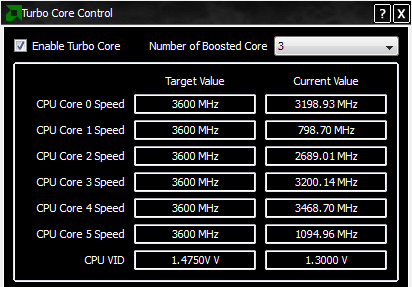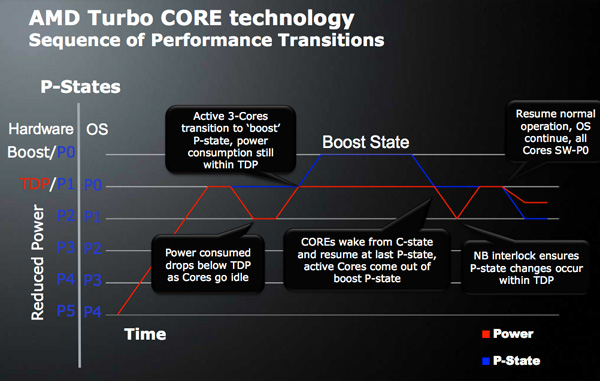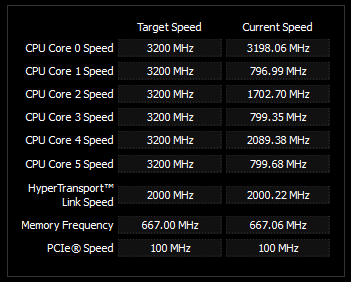AMD's Six-Core Phenom II X6 1090T & 1055T Reviewed
by Anand Lal Shimpi on April 27, 2010 12:26 AM EST- Posted in
- CPUs
- AMD
- Phenom II X6
AMD’s Turbo: It Works
In the Pentium 4 days Intel quickly discovered that there was a ceiling in terms of how much heat you could realistically dissipate in a standard desktop PC without resorting to more exotic cooling methods. Prior to the Pentium 4, desktop PCs saw generally rising TDPs for both CPUs and GPUs with little regard to maximum power consumption. It wasn’t until we started hitting physical limits of power consumption and heat dissipation that Intel (and AMD) imposed some limits.
High end desktop CPUs now spend their days bumping up against 125 - 140W limits. While mainstream CPUs are down at 65W. Mobile CPUs are generally below 35W. These TDP limits become a problem as you scale up clock speed or core count.
In homogenous multicore CPUs you’ve got a number of identical processor cores that together have to share the maximum TDP of the processor. If a single hypothetical 4GHz processor core hits 125W, then fitting two of them into the same TDP you have to run the cores at a lower clock speed. Say 3.6GHz. Want a quad-core version? Drop the clock speed again. Six cores? Now you’re probably down to 3.2GHz.
| Single Core | Dual Core | Quad Core | Hex Core |
 |
 |
 |
 |
 |
 |
 |
 |
This is fine if all of your applications are multithreaded and can use all available cores, but life is rarely so perfect. Instead you’ve got a mix of applications and workloads that’ll use anywhere from one to six cores. Browsing the web may only task one or two cores, gaming might use two or four and encoding a video can use all six. If you opt for a six core processor you get great encoding performance, but worse gaming and web browsing performance. Go for a dual core chip and you’ll run the simple things quickly, but suffer in encoding and gaming performance. There’s no winning.
With Nehalem, Intel introduced power gate transistors. Stick one of these in front of a supply voltage line to a core, turn it off and the entire core shuts off. In the past AMD and Intel only put gates in front of the clock signal going to a core (or blocks of a core), this would make sure the core remained inactive but it could still leak power - a problem that got worse with smaller transistor geometries. These power gate transistors however addressed both active and leakage power, an idle core could be almost completely shut off.
If you can take a single core out of the TDP equation, then with some extra logic (around 1M transistors on Nehalem) you can increase the frequency of the remaining cores until you run into TDP or other physical limitations. This is how Intel’s Turbo Boost technology works. Depending on how many cores are active and the amount of power they’re consuming a CPU with Intel’s Turbo Boost can run at up to some predefined frequency above its stock speed.

With Thuban, AMD introduces its own alternative called Turbo Core. The original Phenom processor had the ability to adjust the clock speed of each individual core. AMD disabled this functionality with the Phenom II to avoid some performance problems we ran into, but it’s back with Thuban.
If half (or more) of the CPU cores on a Thuban die are idle, Turbo Core does the following:
1) Decreases the clock speed of the idle cores down to as low as 800MHz.
2) Increases the voltage of all of the cores.
3) Increases the clock speed of the active cores up to 500MHz above their default clock speed.

The end result is the same as Intel’s Turbo Boost from a performance standpoint. Lightly threaded apps see a performance increase. Even heavily threaded workloads might have periods of time that are bound by the performance of a single thread - they benefit from AMD’s Turbo Core as well. In practice, Turbo Core appears to work. While I rarely saw the Phenom II X6 1090T hit 3.6GHz, I would see the occasional jump to 3.4GHz. As you can tell from the screenshot above, there's very little consistency between the cores and their operating frequencies - they all run as fast or as slow as they possibly can it seems.
| AMD's Turbo Core Benefit | |||||
| AMD Phenom II X6 1090T | Turbo Core Disabled | Turbo Core Enabled | Performance Increase | ||
| x264-HD 3.03 1st Pass | 71.4 fps | 74.5 fps | 4.3% | ||
| x264-HD 3.03 2nd Pass | 29.4 fps | 30.3 fps | 3.1% | ||
| Left 4 Dead | 117.3 fps | 127.2 fps | 8.4% | ||
| 7-zip Compression Test | 3069 KB/s | 3197 KB/s | 4.2% | ||
Turbo Core generally increased performance between 2 and 10% in our standard suite of tests. Given that the max clock speed increase on a Phenom II X6 1090T is 12.5%, that’s not a bad range of performance improvement. Intel’s CPUs stand to gain a bit more (and use less power) from turbo thanks to the fact that Lynnfield, Clarkdale, et al. will physically shut off idle cores rather than just underclock them.

I have noticed a few situations where performance in a benchmark was unexpectedly low with Turbo Core enabled. This could be an artifact of independent core clocking similar to what we saw in the Phenom days, however I saw no consistent issues in my time with the chip thus far.










168 Comments
View All Comments
chrnochime - Tuesday, April 27, 2010 - link
Even with the 930 being 200 at MC(I got one nearby so yes I know that), X58 motherboards are still more expensive overall. The cheapest is 160+, and goes to 400. The thing is with x58, just finding a decent board that doesn't have a bunch of weird problems voiced by owners on forums/newegg is very very difficult. One has to either spend around 300 to perhaps have a higher chance of buying a relatively problem-free board, or just pray the board that arrives doesn't have one of the memory slot DOA(seems to plague quite a few mobos).I don't think the situation is anywhere nearly as bad on AM3 side.
Too bad it's not like the old days (5+ years ago) when boards would just WORK without having to eff around to even keep it stable at stock speed.
vectorm12 - Tuesday, April 27, 2010 - link
I'd really like to see how the 1055T stacks up in terms of overclocking ability.Seems to me as if the 1055T overclocked to around 3.4-3.6 GHz would result in a good stepstone from the current Phenom X4 (non black edition) lineup.
Etern205 - Tuesday, April 27, 2010 - link
Just to give a heads up that Maxxon released a new Cinebenchversion R11.
Roland00 - Tuesday, April 27, 2010 - link
If you are building a new system, of course you will want to use DDR3 memory for there is little to no price difference between the two.But some people have older systems. I wouldn't be surprised if people are upgrade from their AMD 5000+ or 6000+ and they have a compatible motherboard and memory. I am just wondering how much of a bottleneck is the DDR2 and will it cause any rational not to do a partial upgrade but instead a full upgrade.
It doesn't have to be all the tests, just a couple.
Taft12 - Wednesday, April 28, 2010 - link
IIRC the tangible performance benefit from DDR3 over DDR2 is in the range of 2%Higher speed but higher latency.
Goopfruit - Tuesday, April 27, 2010 - link
w00t! Go Netburst!xD
LoneWolf15 - Tuesday, April 27, 2010 - link
That my Q9450 clocked to QX9770-spec is still very competitive.I think it will be awhile before I change platforms, especially what with Intel planning socket changes for 2011. By then, we should see some more interesting options and maybe DDR3 will drop in price --I can always dream.
bigboxes - Tuesday, April 27, 2010 - link
When testing your 1366 i7 CPUs you need to use 6gb of ram. Why? Because they can utilize that extra bandwidth for increased performance. You stated that early on, but since 1156 came out your tests have been only with 4gb of ram. Drop 6gb of ram in the 1366 and retest. I'm sure that is what most 1366 owners are using in their systems.Anand Lal Shimpi - Tuesday, April 27, 2010 - link
In order to keep memory size constant we use 4GB on all systems (4x1GB on the LGA-1366 boards). You get full triple channel access for the first 3GB of memory, only the final 1GB is limited to dual channel. It's the only compromise we could come up with short of giving LGA-1366 a memory size advantage.The vast majority of our tests fall in the 2 - 3GB range, so I don't believe we're holding back the Nehalem/Gulftown performance much if at all here.
Take care,
Anand
Makaveli - Tuesday, April 27, 2010 - link
if most of the benchmarks use only 2-3GB's what differenece then does it make to have the i7 with 6gb of ram?